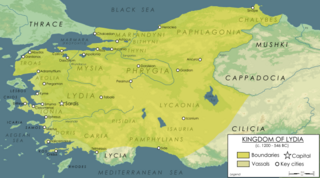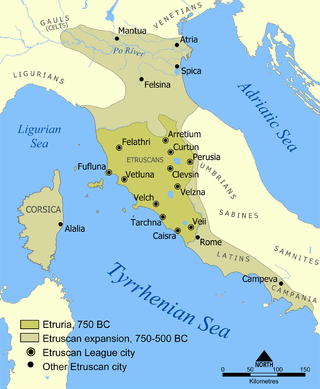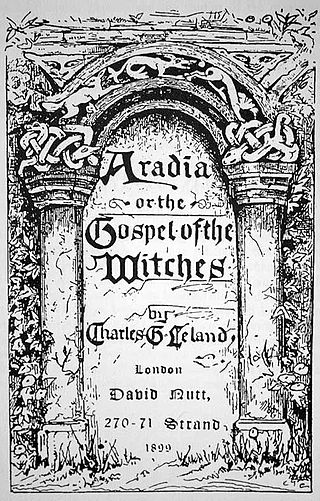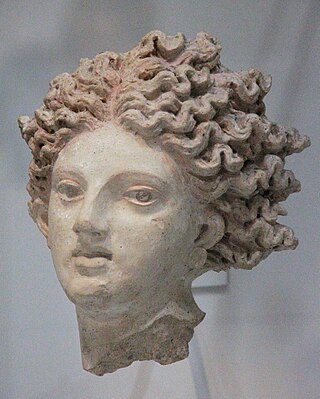
Losna was the Etruscan moon goddess. [1] She is also associated with the oceans and the tides. [2] She is similar to Greek Leucothea. Losna's Roman equivalent is Luna.

Losna was the Etruscan moon goddess. [1] She is also associated with the oceans and the tides. [2] She is similar to Greek Leucothea. Losna's Roman equivalent is Luna.

Diana is a goddess in Roman and Hellenistic religion, primarily considered a patroness of the countryside and nature, hunters, wildlife, childbirth, crossroads, the night, and the Moon. She is equated with the Greek goddess Artemis, and absorbed much of Artemis' mythology early in Roman history, including a birth on the island of Delos to parents Jupiter and Latona, and a twin brother, Apollo, though she had an independent origin in Italy.

Lydia was an Iron Age kingdom situated in the west of Asia Minor, in modern-day Turkey. Later, it became an important province of the Achaemenid Empire and then the Roman Empire. Its capital was Sardis.

Minerva is the Roman goddess of wisdom, justice, law, victory, and the sponsor of arts, trade, and strategy. She is also a goddess of warfare, though with a focus on strategic warfare, rather than the violence of gods such as Mars. Beginning in the second century BC, the Romans equated her with the Greek goddess Athena. Minerva is one of the three Roman deities in the Capitoline Triad, along with Jupiter and Juno.

The Etruscan civilization was an ancient civilization created by the Etruscans, a people who inhabited Etruria in ancient Italy, with a common language and culture who formed a federation of city-states. After conquering adjacent lands, its territory covered, at its greatest extent, roughly what is now Tuscany, western Umbria, and northern Lazio, as well as what are now the Po Valley, Emilia-Romagna, south-eastern Lombardy, southern Veneto, and western Campania.

In ancient Greek mythology and religion, Selene is the goddess and personification of the Moon. Also known as Mene, she is traditionally the daughter of the Titans Hyperion and Theia, and sister of the sun god Helios and the dawn goddess Eos. She drives her moon chariot across the heavens. Several lovers are attributed to her in various myths, including Zeus, Pan, and the mortal Endymion. In post-classical times, Selene was often identified with Artemis, much as her brother, Helios, was identified with Apollo. Selene and Artemis were also associated with Hecate and all three were regarded as moon and lunar goddesses, but only Selene was regarded as the personification of the Moon itself.

In Sabine and ancient Roman religion and myth, Luna is the divine embodiment of the Moon. She is often presented as the female complement of the Sun, Sol, conceived of as a god. Luna is also sometimes represented as an aspect of the Roman triple goddess, along with Diana and either Proserpina or Hecate. Luna is not always a distinct goddess, but sometimes rather an epithet that specializes a goddess, since both Diana and Juno are identified as moon goddesses.

Cloacina was a goddess who presided over the Cloaca Maxima, the main interceptor discharge outfall of the system of sewers in Rome.

Etruscan religion comprises a set of stories, beliefs, and religious practices of the Etruscan civilization, heavily influenced by the mythology of ancient Greece, and sharing similarities with concurrent Roman mythology and religion. As the Etruscan civilization was gradually assimilated into the Roman Republic from the 4th century BC, the Etruscan religion and mythology were partially incorporated into ancient Roman culture, following the Roman tendency to absorb some of the local gods and customs of conquered lands. The first attestations of an Etruscan religion can be traced back to the Villanovan culture.

In Etruscan religion and mythology, Thesan is the Etruscan goddess of the dawn. Thesan is the Roman equivalent of Aurora. In Etruria, she received offerings together with the sun god Usil as described in the liber linteus. She was especially worshipped at Caere's harbour of Pyrgi, where a temple was dedicated to her and a singular series of "daybreak antefixes" was excavated.

In Etruscan religion, Hercle, the son of Tinia and Uni, was a version of the Greek Heracles, depicted as a muscular figure often carrying a club and wearing a lionskin. He is a popular subject in Etruscan art, particularly bronze mirrors, which show him engaged in adventures not known from the Greek myths of Heracles or the Roman and later classical myths of Hercules.

In ancient Greek religion and mythology, Phoebe is one of the first generation of Titans, who were one set of sons and daughters of Uranus and Gaia. She was the grandmother of Apollo and Artemis, and the witchcraft goddess Hecate. According to myth, she was the original owner of the site of the Oracle of Delphi before gifting it to her grandson Apollo. Her name, meaning "bright", was also given to a number of lunar goddesses like Artemis and later the Roman goddesses Luna and Diana, but Phoebe herself was not actively treated as a moon goddess in her own right in ancient mythology.

Maia, in ancient Greek religion and mythology, is one of the Pleiades and the mother of Hermes, one of the major Greek gods, by Zeus, the king of Olympus.

Aradia, or the Gospel of the Witches is a book composed by the American folklorist Charles Godfrey Leland that was published in 1899. It contains what he believed was the religious text of a group of pagan witches in Tuscany, Italy, that documented their beliefs and rituals. Historians and folklorists have disputed the existence of such a group. During the 20th century, the book was influential in the development of the contemporary Pagan religion of Wicca.
In Etruscan mythology, Persipnei or Phersipnai was the queen of the underworld and equivalent to the Greek goddess Persephone and Roman Proserpina. Persipnei was the consort of the divine ruler of the underworld, Aita. Together, both of these deities ruled the Etruscan underworld, which was guarded by Mantus and Mania. Indeed, her name was borrowed by the Etruscans from the Greeks.

The Liver of Piacenza is an Etruscan artifact found in a field on September 26, 1877, near Gossolengo, in the province of Piacenza, Italy, now kept in the Municipal Museum of Piacenza, in the Palazzo Farnese.

The mythologies in present-day Italy encompass the mythology of the Romans, Etruscans, and other peoples living in Italy, those ancient stories about divine or heroic beings that these particular cultures believed to be true and that often use supernatural events or characters to explain the nature of the universe and humanity.
Losna may refer to:

Catha is a female Etruscan lunar or solar deity, who may also be connected to childbirth, and has a connection to the underworld. Catha is also the goddess of the south sanctuary at Pyrgi, Italy.